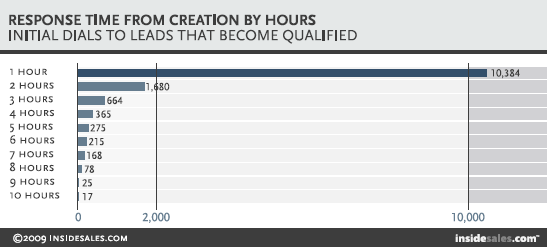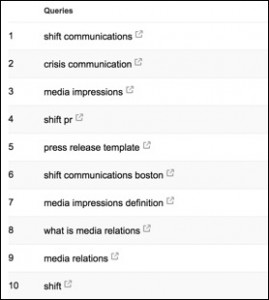Summer is a great time to develop your garden. Delicate seeds require a lot of attention to grow into strong flowers. Just like your garden, the best way to ensure successful sales is to nurture your leads.
Surprisingly, 80% of leads need 5 follow-up calls after the initial meeting to become a sale, but 44% of salespeople give up after only 1 follow-up, leaving a lot of room for improvement. Nurturing leads by making them feel important with a follow up improves the potential for present and future sales. Often a lead requires more than just a sales pitch to be convinced to buy or continue using a product.
Knowing the best time to follow up with leads can be a difficult skill to master. Through trial and error you can determine the best times to contact your leads. To help you get started, here are some techniques we found:
1. Respond NOW
The best time to follow up with a potential client is immediately. The longer you wait the less likely you are to qualify the lead.
The odds of qualifying a lead decreases 6 times over the first hour. Waiting more than five minutes before contacting your lead causes the chances of closing a sale to decrease 4 times, and 21 times if you wait 30 minutes.


After speaking with a potential client, they know your sales pitch. Increase your product’s value by feeding them important information through testimonials and a mockup of your product. This helps them better understand your product how your product can help them. You can also include answers to FAQs so the customer feels satisfied with their knowledge of your product.
Each lead is different. You might need to some nurture leads more than others, and do so in different ways. It is good to have a script to use, but don’t be afraid to adapt your follow up routine to your lead.
You should aim to attain more information from the lead after each point of contact to make your future sales more successful. Personalizing a message to the lead makes them feel important.
2. Determine their value
Some leads require more of a push to buy a product. Others will never buy no matter how much you contact them. It is important to determine how likely a lead is to buy your product to determine the amount of time and resources to allot to cultivating them.
Hearing ‘no’ from a lead may not be the reaction you want, but it is a good response to help you choose how much time to focus on the lead. Getting a no can be better than a weak ‘maybe’. With a ‘no’ you can stop spending time on a lead and move on to new potential clients.
Spending time and money on a low-probability prospect wastes resources that could have been used to nurture a more promising lead. Value determination helps you decide the amount of resources to dedicate to the lead.
To establish the value of a lead you need to consider how much effort and resources you will spend on the lead, and what the ROI will likely be. Not that you should entirely stop contact with them if their ROI seems low, but allocate less resources to a lead that is not as likely to yield results.
Even if a potential client does not have a present need for your product, it may be of use to them in the future. Getting a read on the value of the lead, and establishing a relationship is important to get the potential client to become a sale in the future. If this is the case then put the potential in a lead nurturing program: keep them up to date with your company and offer them other products they may have a more present need for.
To better understand how to promote your product to a potential client, check out Hewitt’s post on mastering the follow-up. Your follow up should add value for them, not just for you.
3. Go after them
Many clients will be unresponsive to your first five follow-ups. If you really want to keep up with a client, don’t worry too much about being annoying: persistence is key!

As Sabel points out in her blog post, “people are genuinely busier these days and following up more than once can ensure the proper engagement”. Following up helps you fill the communication gap by keeping your clients informed after a purchase or during their decision.
4. Establish a relationship
If a client has purchased your product, continue nurturing your relationship to increase the potential of sales in the future.
With follow-up messages you can better understand your customer’s needs. For instance ask what they like about your product and what can be improved. Later, based on the information gathered, tailor your actions to better suit their needs and sell your product when the opportunity arises. By getting feedback you are able to see what type of value you have provided to your client. If you have an effective product, your client is more likely to refer you to others, thus increasing sales.
Make sure contact with leads is valuable and important. Share interesting bits of information that the lead will find useful and relevant. The more applicable your material is, the better your lead’s response should be. Sending pointless fluff to a lead will only clog their inbox and give them a negative perception of your business.
5. Recap
Following a meeting, send out a message reviewing the information you discussed with a lead. If the lead seemed to respond well to particular information, talk that up in your recap. You can understand what excites a client by noting their body language, paying attention to positive reactions, and what points and features caused a response.
6. Set a Schedule
You will have to work out the best follow up schedule for your clients as well as the best platform to contact them. Should you email or call? Morning or evening? What is the best amount of contact for your clients? You can figure out what works best for you by analyzing what leads turn into purchasing customers and which leads fizzle out.
The best times to contact leads to qualify them for purchase are Wednesdays and Thursdays between 8 to 9 am or 4 to 6 pm. Emedia found that a great way to establish a relationship with a lead was to contact them within one day. For an initial schedule plan, this would be a good strategy, then adapt it to best fit your organization.
Don’t be afraid to alter your schedule in order to figure out what timeline works best for you. You should try various times on different days as well as the length of time between to responding to a lead.
Keep in mind if you have international clients, or clients in another region, then time zones will effect your delivery times. Having flexibility in with your follow-up schedule will help you deal with time zones and give you more opportunities to experiment.

http://blog.getresponse.com/best-time-to-send-email-infographic.html
Emedia also found that for difficult to reach leads, calling and leaving a voicemail, then emailing the lead the following day tends to be a good strategy to progress further. A quick follow up with a lead will set your business apart and keep you fresh in their mind.
Also, it is important to note that not all leads will respond the same. Some leads are hard to reach, and will need more consistent attention. Others may require less attention to qualify as a sale. Your leads will also react in different ways: what one sees a a personal and friendly follow up, another may see as creepy and invasive. Depending on how your clients react, tailor your future follow ups to what fits your market best.
Having a system in place will help you maintain relationships with your clients as well as nurture leads. As Hewitt points out, following up and nurturing your leads is not a stagnant activity. You need to be making a continuous effort with your leads and constantly aim to improve your methods. Once you discover the best method, stick to it and watch your leads grow!
(310)
Report Post







